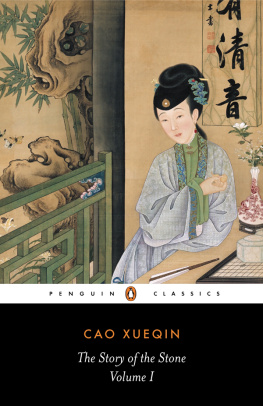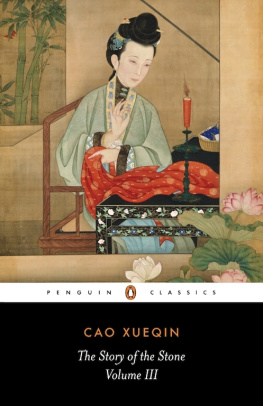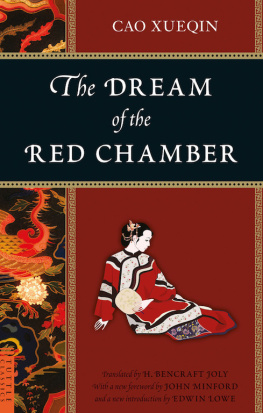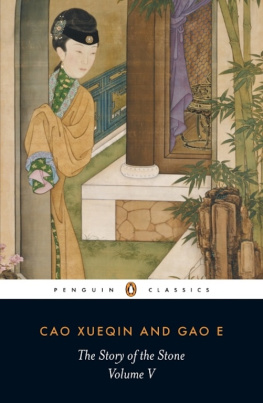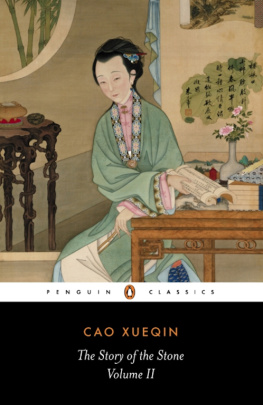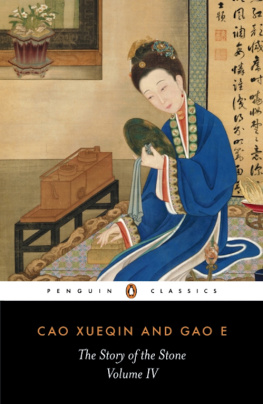Cao Xueqin - The Story of the Stone
Here you can read online Cao Xueqin - The Story of the Stone full text of the book (entire story) in english for free. Download pdf and epub, get meaning, cover and reviews about this ebook. year: 2013, publisher: Penguin Books Ltd, genre: Detective and thriller. Description of the work, (preface) as well as reviews are available. Best literature library LitArk.com created for fans of good reading and offers a wide selection of genres:
Romance novel
Science fiction
Adventure
Detective
Science
History
Home and family
Prose
Art
Politics
Computer
Non-fiction
Religion
Business
Children
Humor
Choose a favorite category and find really read worthwhile books. Enjoy immersion in the world of imagination, feel the emotions of the characters or learn something new for yourself, make an fascinating discovery.
- Book:The Story of the Stone
- Author:
- Publisher:Penguin Books Ltd
- Genre:
- Year:2013
- Rating:5 / 5
- Favourites:Add to favourites
- Your mark:
- 100
- 1
- 2
- 3
- 4
- 5
The Story of the Stone: summary, description and annotation
We offer to read an annotation, description, summary or preface (depends on what the author of the book "The Story of the Stone" wrote himself). If you haven't found the necessary information about the book — write in the comments, we will try to find it.
The Story of the Stone — read online for free the complete book (whole text) full work
Below is the text of the book, divided by pages. System saving the place of the last page read, allows you to conveniently read the book "The Story of the Stone" online for free, without having to search again every time where you left off. Put a bookmark, and you can go to the page where you finished reading at any time.
Font size:
Interval:
Bookmark:
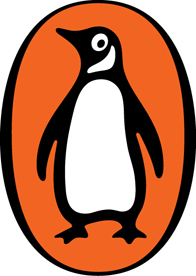

UK | Canada | Ireland | Australia
New Zealand | India | South Africa
Penguin Books is part of the Penguin Random House group of companies whose addresses can be found at global.penguinrandomhouse.com.

This translation first published 1973
Copyright David Hawkes, 1973
Cover: Detail from a hanging scroll by an anonymous mid-18th- to 19th-century Chinese artist, showing a beauty holding an orchid (Arthur M. Sackler Gallery, Smithsonian Institution, Washington, DC: Purchase Smithsonian Collections Acquistions Program and partial gift of Richard G. Pritzlaff, S1991.50).
All rights reserved
ISBN: 978-0-141-93516-4

Let the conversation begin
Follow the Penguin Twitter.com@penguinukbooks
Keep up-to-date with all our stories YouTube.com/penguinbooks
Pin Penguin Books to your Pinterest
Like Penguin Books on Facebook.com/penguinbooks
Listen to Penguin at SoundCloud.com/penguin-books
Find out more about the author and
discover more stories like this at Penguin.co.uk
PENGUIN CLASSICS
ADVISORY EDITOR: BETTY RADICE
Cao Xueqin (1715?63) was born into a family which for three generations held the office of Commissioner of Imperial Textiles in Nanking, a family so wealthy that they were able to entertain the Emperor Kangxi four times. But calamity overtook them and their property was confiscated. Cao Xueqin was living in poverty near Peking when he wrote his famous novel The Story of the Stone, of which this is the first volume. The four other volumes, The Crab-Flower Club, The Warning Voice, The Debt of Tears and The Dreamer Awakes, are also published in Penguin Classics.
David Hawkes was Professor of Chinese at Oxford University from 1959 to 1971 and a Research Fellow of All Souls College, from 1973 to 1983. He now lives in retirement in Wales.
TO DOROTHY AND JUNG-EN
It is a somewhat surprising fact that the most popular book in the whole of Chinese literature remained unpublished for nearly thirty years after its authors death, and exists in several different versions, none of which can be pointed to as definitively correct.
From 1763, the year in which Cao Xueqin died, until the appearance of the first printed edition in January 1792, The Story of the Stone circulated in manuscript copies, at first privately, among members of the Cao family and their friends, and then more widely, as copies began to find their way on to bookstalls at the temple markets of Peking. One such copy was bought in 1769 by a future Provincial Judge who happened to be staying in Peking at the time to sit for an examination. It was published in Shanghai in a somewhat garbled form a century and a half later.
These manuscript copies included a commentary consisting of the remarks, in many cases signed and dated, of two or three different commentators, evidently made over a period of years, and written, often in red ink, in the manuscripts margins and in the spaces between the text. They circulated in several different versions, both the commentary and the text differing somewhat from copy to copy, but they all had two things in common: they were all entitled Red Inkstones Reannotated Story of the Stone; and they all, to the intense disappointment of their readers, broke off at the end of chapter 80, just as the plot appeared to be drawing towards some sort of climax.
The appearance of a complete version in 120 chapters in Gao E and Cheng Weiyuans first printed edition of 1792 did not immediately end the lucrative traffic in hand-written copies, because the first printed edition was an expensive one; but its subsequent pirating in cheaper reprints by other publishers did; and though a dwindling number of cognoscenti still clung to their Red Inkstones and denounced Gao Es edition as an impudent (or ignorant) imposture, the majority of readers were well satisfied with the completed version. No longer was the Stone to be found only in the drawing-rooms of Manchu noblemen. Soon everyone in Peking was reading and talking about it, and throughout the whole of the nineteenth century its popularity continued to grow and spread. Old gentlemen nearly came to blows over the relative merits of its two heroines and every languishing young lady imagined herself a Dai-yu.
As the Gao E version became more and more established, continuing to hold its own against a crop of competing but quite obviously spurious complete versions including one equipped with a forged testimonial by Xueqins mother so Red Inkstone and his commentaries were gradually forgotten. Indeed, people even forgot about Cao Xueqin; for although he mentions himself by name in the first chapter, he does so in a spoofing, ironical way which seems to imply that he was only the books editor and not its author, and when Gao E and Cheng Weiyuan introduced the book to the general public in 1792 they told their readers that the authors name was unknown.
Once Cao Xueqins authorship was forgotten, all sorts of fanciful theories about the author and his characters could flourish unchallenged. Readers assumed that the novel was a roman clef, but now that they had ceased to know about Cao Xueqin and his family they had lost the key. Stone studies became a sort of literary hobby, like identifying Mr W. H. or proving that Bacon wrote Shakespeare.
In modern times such facts as we know about this novel have had to be laboriously rediscovered. The publication of the Judges manuscript in 1912 was a beginning. Unfortunately the manuscript itself was burned only a few years later and the printed version was a somewhat garbled one. But since 1927, when an important fragment of Red Inkstone came to light, more and more manuscripts have emerged from obscurity, and by studying them and comparing what could be learned from them with such information as could be gleaned from eighteenth-century archives and from the letters and poems of the Caos and their friends, Chinese scholars have been able to reconstruct a fairly detailed picture of the novels background. Much, however, still remains uncertain and mysterious. Opinions shift and change from year to year as more manuscripts and other new materials continue to come to light. New theories are continually being propounded and old ones heatedly defended or acrimoniously attacked, so that it is difficult to give an account of the novel that will not seem dated in a year or twos time.
In writing this account I have relied heavily on the published researches of Chinese scholars like Yu Pingbo, Zhou Ruchang, Wu Shichang and Zhao Gang particularly the last, whose theories on a number of controversial issues seem to me the most convincing. Wu Shichang is the only one of these scholars whose work is available in English. His book
Font size:
Interval:
Bookmark:
Similar books «The Story of the Stone»
Look at similar books to The Story of the Stone. We have selected literature similar in name and meaning in the hope of providing readers with more options to find new, interesting, not yet read works.
Discussion, reviews of the book The Story of the Stone and just readers' own opinions. Leave your comments, write what you think about the work, its meaning or the main characters. Specify what exactly you liked and what you didn't like, and why you think so.

